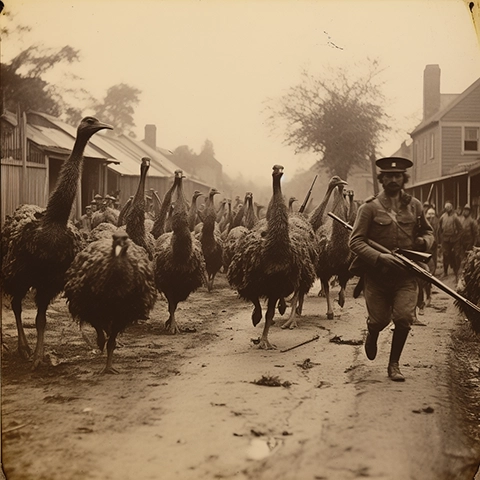In the annals of Australian lore, few tales are as beguiling and shadowed in myth as the Great Emu Uprising of 1886. Though lesser-known than its latter-day counterpart, the ‘Emu War’ of 1932, this earlier chapter unfolds a narrative where the emus are not mere marauders of the wheatbelt but, rather, calculated tacticians in their own right.
The year was 1886, a time when the Australian outback was a vast, untamed canvas, and the nation was yet budding in its post-colonial adolescence. The inland territories whispered of riches and bountiful harvests, and so it drew a determined sort of settler, those willing to stake their future in the red dirt and under the vast blue skies.
Unbeknownst to these pioneers, their intrusions into the emus’ ancestral lands would ignite an uprising of a most peculiar kind. The emus, led by a formidable elder known only in legend as ‘Tall Feathers’, began to display uncanny strategic foresight. It was as if the spirit of some ancient warlord had taken residence within Tall Feathers, prompting the birds to a rebellion not merely for sustenance, but for sovereignty.
The first sign of rebellion came with the mysterious destruction of fences. Settlers awoke to find their wooden boundaries uprooted, not trampled, but extracted with methodical precision, as if removed by the hands of a nocturnal army. Soon after, water supplies began to deplete, not by natural drought, but by what appeared to be orchestrated sabotage, leaving troughs bone-dry under the unyielding sun.
As the settlers grew weary, accounts of the emus’ tactical brilliance began to spread. It was said that Tall Feathers would survey the fields, his gaze piercing and contemplative, before emitting a sequence of guttural calls, each one seemingly a command that sent platoons of his feathered followers into action. Under the cover of the ghost gums, they would wait until the moment of the farmers’ rest to enact their campaigns.
It wasn’t long before the settlers, some of whom had military acumen from prior colonial skirmishes, took notice of the patterns. They saw, with begrudging respect, that the emus had scouts, sentries, and what could only be described as a rudimentary form of communication signaling. At night, the emus’ cries would echo through the darkness, each call a note in an avian symphony that spelled doom for the crops of the season.
Desperation drove the settlers to a military response. Armed with their hunting rifles, they sought to curtail the uprising, only to find themselves outmaneuvered at every turn. The emus, under the cloak of dust storms they seemed to anticipate, would vanish into the brush, their paths covered by the swirling red sands.
In the most astonishing of skirmishes, the settlers recounted a ‘Battle of the Wheat Fields’ where the emus appeared to have anticipated their advance, drawing the humans into a chase that led to an orchestrated ambush where the settlers were encircled by a maelstrom of wings and wind. The birds’ formations, it seemed, had been a ruse, a feigned retreat that turned into a counterattack.
The conflict reached its zenith when the settlers, battered and bested by the avian insurgency, decided upon a parley with the emus. Led by a decorated officer, they approached Tall Feathers with an offering of truce: a portion of the harvest, left in peace, in exchange for a cessation of hostilities. To their amazement, the elder emu, with a solemn nod, seemed to accept.
The Great Emu Uprising of 1886 thus ended not with the boom of guns, but with the stillness of a détente. In the folklore that followed, the emus of the Australian outback were forever emblazoned as creatures of cunning and courage, led by the enigmatic Tall Feathers, whose grave was never found but whose legacy cast a long shadow over the bushland.
In the years to come, the uprising was remembered not as a tale of conflict but as a parable of respect and coexistence with the land and its original custodians. And while historians may debate the facts, the legend of the Great Emu Uprising of 1886 persists, a fable of feathers and fields where birds became warriors, and nature, it seemed, fought back.

